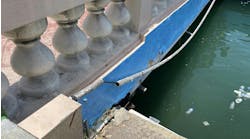How well do you know the Code? Think you can spot violations the original installer either ignored or couldn't identify? Here's your chance to moonlight as an electrical inspector and second-guess someone else's work from the safety of your living room or office. It's your turn to identify the violation.
Hint: A Hodgepodge of lighting equipment
Find the Answer
Mounting a box on the end of rigid metal conduit (RMC) for the installation of lampholders and luminaires needs to be done in a very specific manner in order to be Code compliant. This installation falls a bit short, don’t you agree?
Exception No. 2 to the general rule in Sec. 314.23(F) allows a box for a luminaire to be supported by only one conduit under all of the following specific conditions.
1) The conduit extending out beyond the last support is no longer than 3 ft.
2) At least 1 ft of conduit is supported at no less than 1 ft before the last support.
3) The lowest point of any lampholder or luminaire is at least 8ft above grade where accessible to unqualified persons.
4) No luminaire exceeds 12 in. in any direction from the conduit entry.
5) The maximum weight the conduit supports is not more than 20 lbs.
6) The conduit must be threaded into the box supporting the luminaires or lampholders. The conduits in this photo were not threaded into the boxes. Compression connectors were used to secure the conduits to the boxes. This is not permitted. The connectors could loosen causing the boxes and fixtures to fall and hurt someone.





